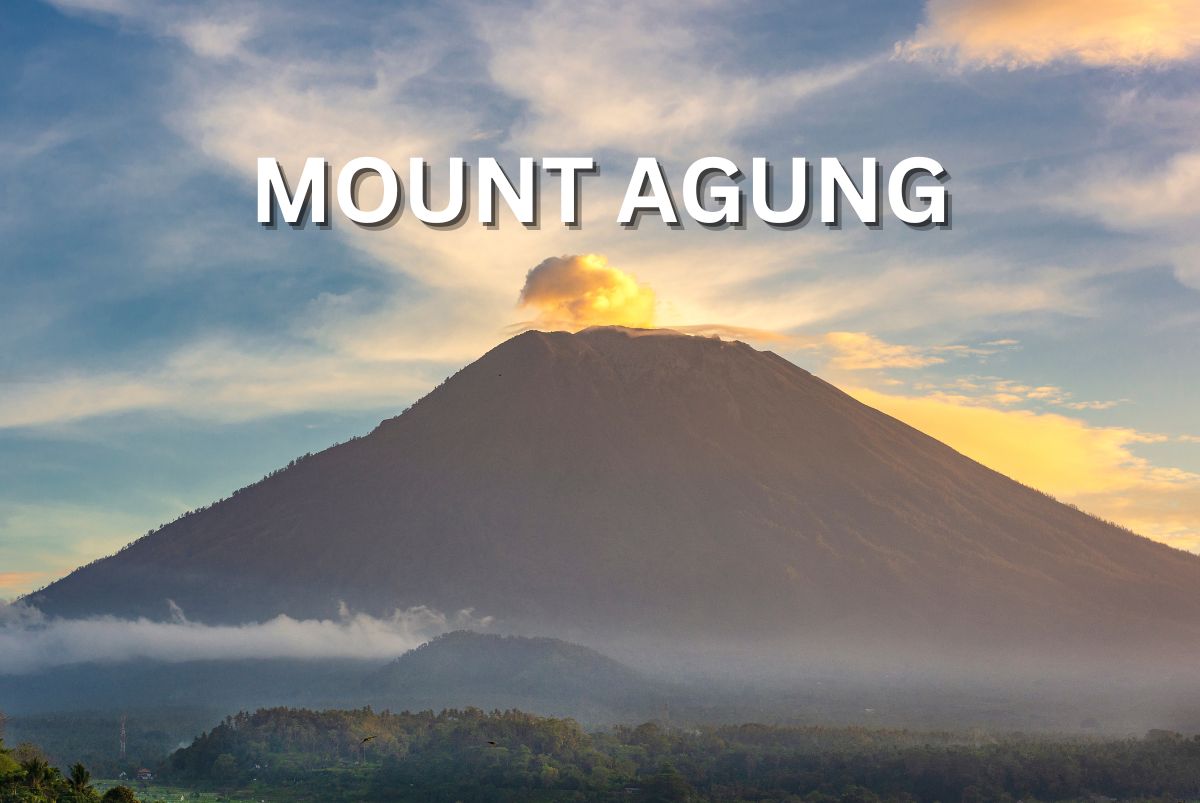Mount Agung is Bali’s tallest peak and a place of deep spiritual importance. Standing at over 3,031 meters, it’s not just any volcano – it’s a sacred spot for many. This volcano is home to Pura Besakih, one of Bali’s more important temple. It’s more than just a place to visit; it’s a part of Bali’s soul. The mountain shapes the weather and life on the island. When you see Mount Agung, you’re seeing a piece of Bali’s heart. It’s a challenge to climb, but even just looking at it, you feel something special. This mountain is not just about height; it’s about what it means to the people here.
Geographical and Geological Profile of the Volcano Agung
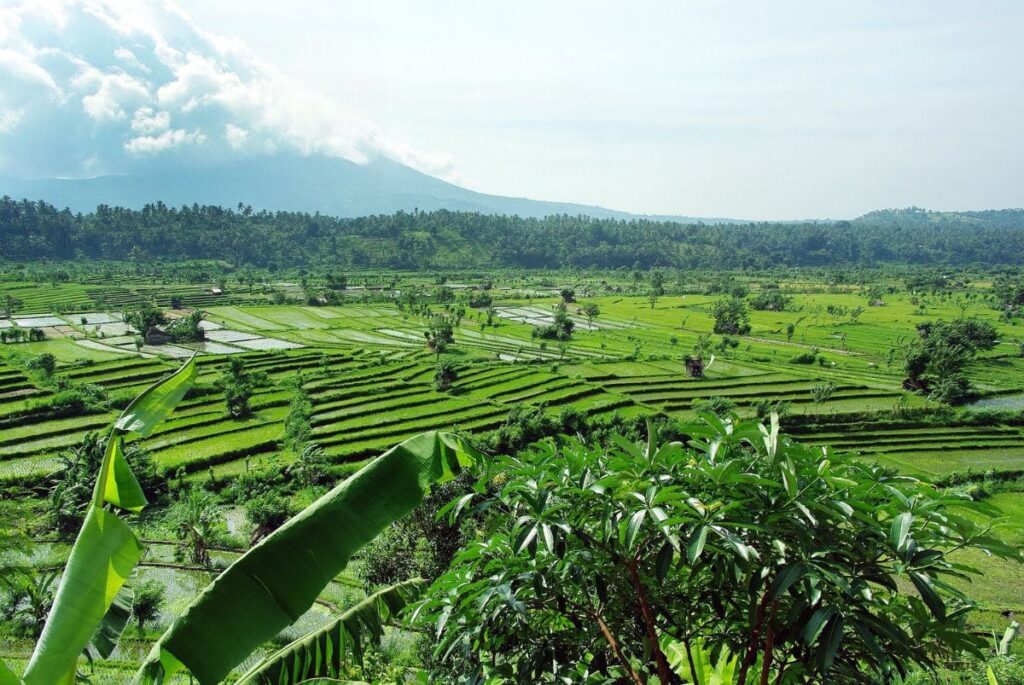
Agung is known as a stratovolcano and is one of the 3 very well known volcanoes in Bali. This is a fancy way of saying it’s made up of many layers. These layers come from different eruptions over time, each adding ash, lava, and rocks. It’s like a history book, but instead of pages, it has layers of volcanic material.
Now, let’s talk about its eruptions. Mount Agung is pretty famous for its volcanic activity. It’s not the kind of volcano that erupts all the time, but when it does, it’s a big deal. The eruptions can be explosive, sending ash high into the sky and sometimes spewing out lava. These aren’t just small events; they can change the landscape around the volcano and even affect the weather.
The type of eruptions Agung has can vary. Sometimes it’s just ash and gas, but other times it can include lava flows. These flows can travel down the mountain, reshaping the land as they go. It’s a reminder of the power of nature and how it can shape our world.
Mount Agung has a history marked by two major eruptions that deeply impacted Bali and beyond. The first one, in 1963, and the more recent series of eruptions from 2017 to 2019, each tell a story of nature’s power and human resilience. (source: Wikipedia on Mount Agung)
Where is Mount Agung?
It’s situated in the eastern part of Bali, dominating the surrounding landscape. This active volcano is part of the Pacific Ring of Fire, known for its significant volcanic activity. Mount Agung is near the district of Karangasem, offering breathtaking views visible from various points on the island.
When did Mount Agung erupt?
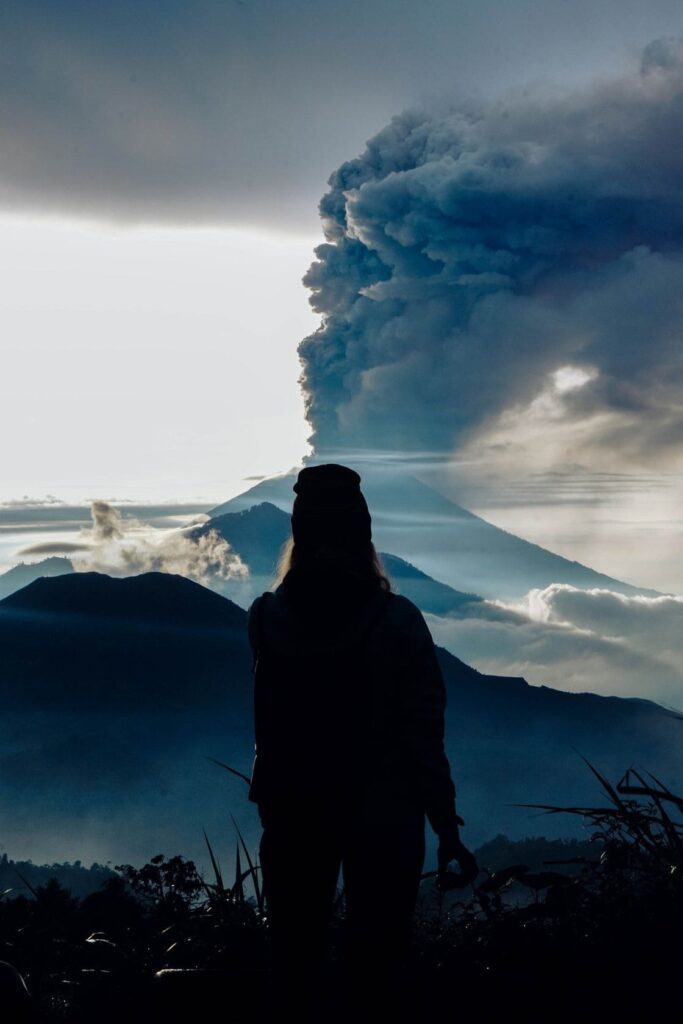
The 1963 Eruption of Volcano Agung
Back in 1963, after being quiet for 120 years, Mount Agung suddenly erupted. It was huge – one of the biggest eruptions in Indonesia’s history. It all started with loud bangs in February. By March 17, it was full-on chaos. The volcano spewed ash and stuff up to 8 to 10 kilometers high. This eruption caused massive flows of hot ash and gas (pyroclastic cloud) that wiped out lots of villages and killed about 1,100 to 1,500 people. After that, there were these mudflows because of the rain, which caused even more damage. The miracle part? The lava flows just missed the Mother Temple of Besakih. People thought it was a miracle that it didn’t get destroyed.
The 2017-2019 Eruptions
Fast forward to 2017, and Mount Agung started rumbling again. This time there was a lot of shaking, ash clouds, and some lava too. The authorities had to put the highest alert out there, and over 100,000 people had to leave their homes. The airport even had to shut down a bunch of times because of all the ash in the air. These eruptions weren’t as deadly as the one in 1963, but they still hit Bali’s tourism and economy pretty hard. But you know what? The people in Bali were amazing. They helped each other out and got through it all.
I remember that this is when Bali got deserted for 3 months! it was sad to see such a lively island being abandoned.
Impact of the erupting volcano
Both eruptions had profound effects. In 1963, the eruption led to a significant loss of life and property, deeply affecting the local communities. The 2017-2019 eruptions, while less deadly, disrupted lives and livelihoods, particularly in tourism, which is a major economic driver in Bali. Despite these challenges, the Balinese people showed incredible strength and resilience. They rallied together, supporting evacuees and rebuilding their communities.
The Cultural Significance of Mount Agung
People see it as a sacred spot, like a bridge between the earth and the heavens. This mountain is a big deal in the local culture and beliefs
For the Balinese Hindus, Mount Agung is more than just a landmark. They think of it as the home of the gods. It’s like their version of Mount Meru, a really important mountain in Hindu stories. Because of this, Mount Agung is a key spot for religious events and offerings.
Right on Mount Agung, there’s this ancient temple complex called Pura Besakih. It’s over a thousand years old and really important for religious stuff in Bali. It’s got 23 different temples, each one special in its own way. Pura Besakih is not just for praying; it shows how much the Balinese people love their gods and feel connected to Mount Agung. When the temple didn’t get destroyed in the big eruption in 1963, people thought it was a miracle.
There are lots of stories and beliefs about Mount Agung. Some people say the gods put the mountain in Bali to keep the island stable. Others think the mountain is a piece of Mount Meru that the gods brought to Bali. These stories aren’t just old tales; they show how important Mount Agung is in Bali. It’s part of their religion and everyday life, giving them inspiration and a sense of wonder.
How does Mount Agung affect the weather and climate
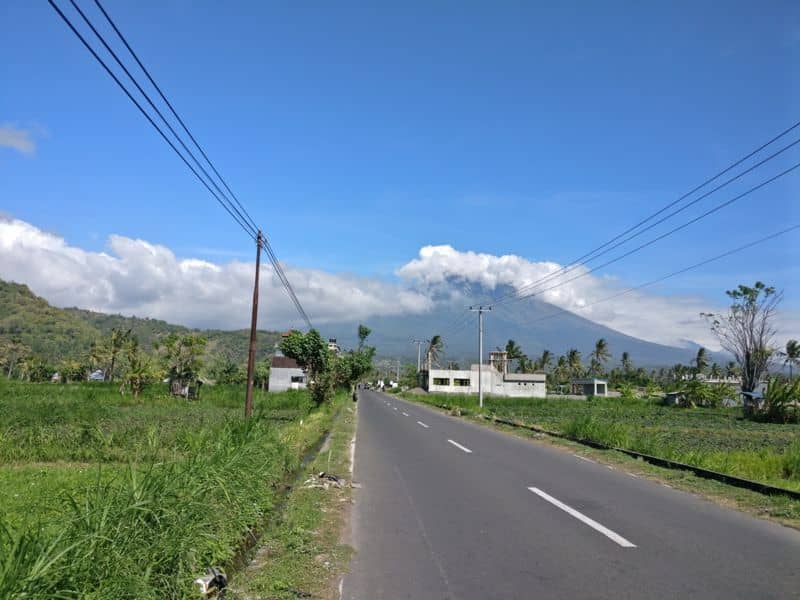
The height of Mount Agung plays a big part in how the weather behaves around it. Here’s what happens: the winds coming from the Indian Ocean carry a lot of moisture. When these moist winds hit the tall slopes of Mount Agung, they’re forced upwards. As they rise, the air cools down, and all that moisture turns into rain. This process is called ‘orographic lift,’ and it’s like Mount Agung is squeezing the clouds to make it rain. Because of this, the western side of the mountain gets a lot of rain. It’s a different story on the eastern side, though. The mountain acts like a huge umbrella, keeping the east drier. So, one side of the mountain is often wet and cloudy, while the other side can be sunny and dry.
All this rain on the western side is a big win for farming. The soil there gets plenty of water, making it rich and fertile. It’s perfect for growing all sorts of crops. Farmers in this area mainly grow rice, but they also have lots of fruit trees and vegetable gardens. The rain from Mount Agung helps these plants grow well. The western slopes are like a patchwork of lush green rice terraces and gardens. It’s not just about the amount of rain, though. The way the rain is spread out over the year also helps. It means farmers can plan their planting and harvesting times better. This side of Mount Agung is a busy place for agriculture, all thanks to the mountain’s rain-making powers.
Trekking Volcano Agung
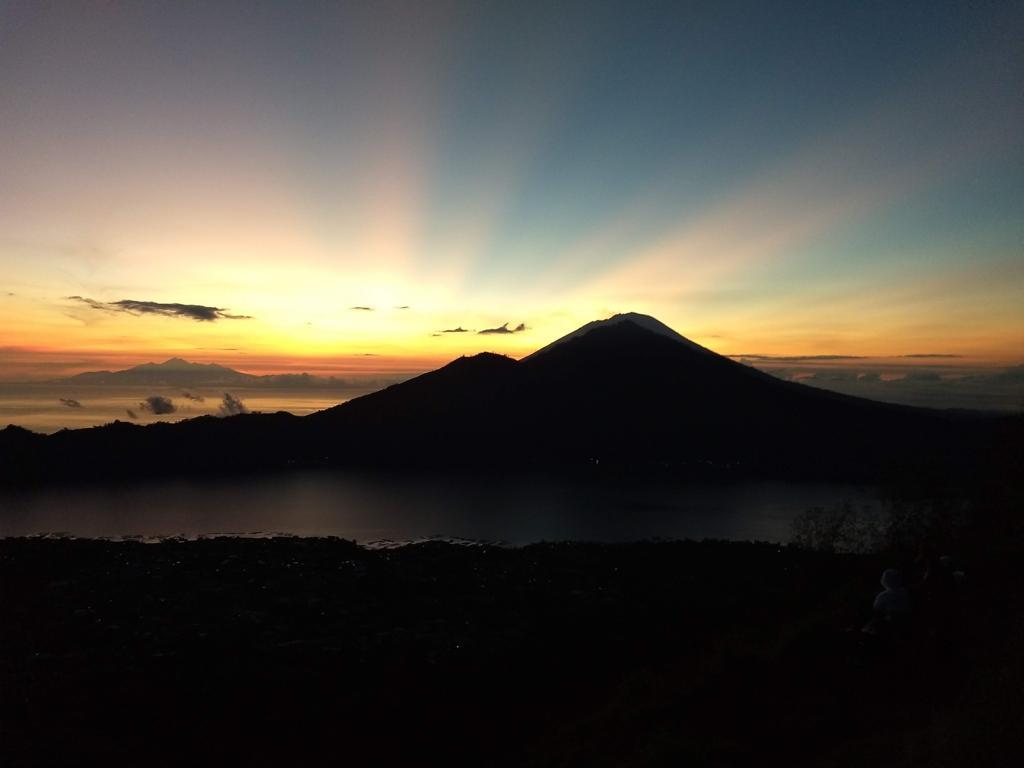
There are two main paths to trek Mount Agung, and each has its own set of challenges. The first route starts at the Pasar Agung Temple. It’s shorter but still tough, taking about 3 to 4 hours to reach the summit. The path is steep and rocky, and as you get higher, it gets more challenging. The second route begins at the Besakih Temple, known as the ‘Mother Temple’ of Bali. This one’s longer and takes about 5 to 7 hours to reach the top. It’s a more gradual climb at first, but don’t let that fool you. It gets pretty steep and demanding as you go higher.
Both routes offer amazing views, but they’re not for the faint-hearted. You’ll be climbing on uneven terrain, dealing with altitude changes, and maybe even facing some cold and windy conditions as you get closer to the summit.
Best Times for Trekking
The best time to trek Mount Agung is during the dry season, from April to October. During these months, the weather is more predictable, and you’re less likely to encounter rain, which can make the trek slippery and more dangerous. Plus, the clearer skies mean you’ll get those breathtaking views you’re hoping for.
If you’re aiming for a truly unforgettable experience, start your trek in the early hours of the morning. That way, you can reach the summit in time to catch a magical sunrise over Bali. It’s a tough night trek, but seeing the sunrise from above the clouds is totally worth it.
Personal Experiences and Tips
From personal experiences and stories from other trekkers, here are some tips to make your Mount Agung trek a success:
- Fitness is Key: Make sure you’re in good physical shape. This trek is demanding, and you’ll enjoy it more if you’re fit.
- Hire a Guide: It’s highly recommended to trek with a local guide. They know the best paths and can help you stay safe.
- Pack Smart: Bring layers of clothing. It can be warm at the bottom and cold at the top. Don’t forget a good headlamp, as you’ll likely be trekking in the dark.
- Stay Hydrated and Energized: Bring enough water and some high-energy snacks. Keeping hydrated and energized is crucial.
- Respect the Mountain: Remember, Mount Agung is sacred to the Balinese people. Be respectful during your trek.
Volcanic Activity of Mount Agung
Mount Agung’s activity can change, so it’s always monitored closely. The alert level for the volcano can range from normal to watchful, and sometimes even to warning levels if there’s a lot of activity. These levels are based on things like earthquakes around the mountain, changes in the shape of the volcano, and gas emissions. It’s super important to check the current alert level before planning a trek. The Indonesian Center for Volcanology and Geological Hazard Mitigation (CVGHM) keeps an eye on this and updates the status regularly.
The CVGHM (The Indonesian Center for Volcanology and Geological Hazard Mitigation), along with other local authorities, plays a big role in keeping everyone safe. They use tools like seismographs to track earthquakes, GPS to notice changes in the mountain’s shape, and gas sensors to check for dangerous gases. If they see something worrying, they can raise the alert level and even tell people to evacuate if needed. They also decide when it’s safe to trek Mount Agung and will close the trails if there’s too much risk.
Final thoughts
This volcano is amazing. It’s super tall and can be seen from all over Bali. For the people who live there, it’s a sacred place. They believe it’s the home of the gods. Mount Agung is not just about the great views or the cool treks. It’s a big part of what makes Bali, Bali. The mountain affects the weather, helps farmers grow food, and is a place where important ceremonies happen.
Thank you for reading!
Hi I am Dwi. I am a blogger, travel agent and a mom of a lovely daughter and wife to a supportive husband. I customize and plan tours in Bali and islands nearby for a living and have been doing this for more than 14 years. Get in touch via contact [at] taletravels.com
